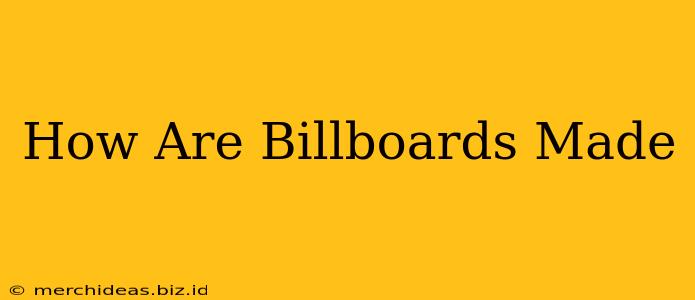Billboards. Those massive, eye-catching advertisements that dominate our highways and cityscapes. But have you ever wondered about the journey from concept to completion? This comprehensive guide delves into the fascinating process of billboard creation, from initial design to final installation.
The Design Phase: Bringing Your Vision to Life
The creation of a billboard begins long before the first piece of vinyl is printed. It starts with a strong concept. Effective billboard design requires a keen understanding of visual communication and the target audience. Key aspects of this phase include:
1. Concept Development and Messaging:
- Clear and Concise Message: Billboards need to communicate a message quickly and effectively. Think short, punchy slogans and impactful visuals. Remember, drivers only have a few seconds to take it all in.
- Target Audience Analysis: Who are you trying to reach? Understanding your audience informs the design style, imagery, and overall tone.
- Brand Consistency: The billboard should align with the overall brand identity and marketing strategy.
2. Choosing the Right Design Elements:
- Imagery: High-quality images are crucial. Think bold colors, strong contrasts, and impactful visuals that can be easily seen from a distance.
- Typography: Large, easy-to-read fonts are essential. Keep the text to a minimum, focusing on keywords and a clear call to action.
- Color Palette: Select a color scheme that is both eye-catching and complements your brand. Consider the surrounding environment and how the colors will appear in different lighting conditions.
3. Layout and Composition:
- Visual Hierarchy: Guide the viewer's eye to the most important elements of the design.
- White Space: Don't overcrowd the billboard. Strategic use of white space can improve readability and visual appeal.
- Call to Action: Include a clear call to action, such as a website address or phone number, encouraging viewers to take the next step.
The Production Phase: From Design to Reality
Once the design is finalized, the production process begins. This involves several crucial steps:
1. Printing:
- Large-Format Printing: Specialized printers utilize high-resolution technology to produce vibrant and durable billboard prints on vinyl or other suitable materials.
- Material Selection: The choice of material depends on factors like durability, weather resistance, and budget. Vinyl is a popular choice due to its longevity and weather resistance.
- Color Calibration: Accurate color matching is crucial to ensure the final product accurately represents the design.
2. Lamination:
- Protection from the Elements: Lamination adds a protective layer to the printed material, safeguarding it from sun, rain, and wind damage. This ensures the billboard remains vibrant and readable for an extended period.
3. Cutting and Finishing:
- Precise Cutting: The printed material is precisely cut to the exact dimensions of the billboard.
- Finishing Touches: Any additional elements, such as grommets for installation, are added during this stage.
Installation: Getting Your Billboard Up and Seen
The final stage involves the installation of the finished billboard. This typically requires a team of experienced professionals who use specialized equipment to safely and securely mount the billboard to its designated location. This often involves:
1. Site Preparation:
- Accessibility and Safety: Ensuring safe access to the billboard location is critical for the installation crew.
- Structural Integrity: Checking that the structure is strong enough to support the weight of the billboard.
2. Mounting and Securing:
- Secure Installation: Using appropriate hardware and techniques to ensure the billboard is securely mounted and will withstand various weather conditions.
3. Final Inspection:
- Quality Control: A final inspection ensures the billboard is properly installed and meets the client's specifications.
From the initial creative spark to the final installation, the creation of a billboard is a complex process involving creativity, precision, and expertise. Each step contributes to the end result: a powerful and impactful advertisement that captures attention and delivers a message to a wide audience.
